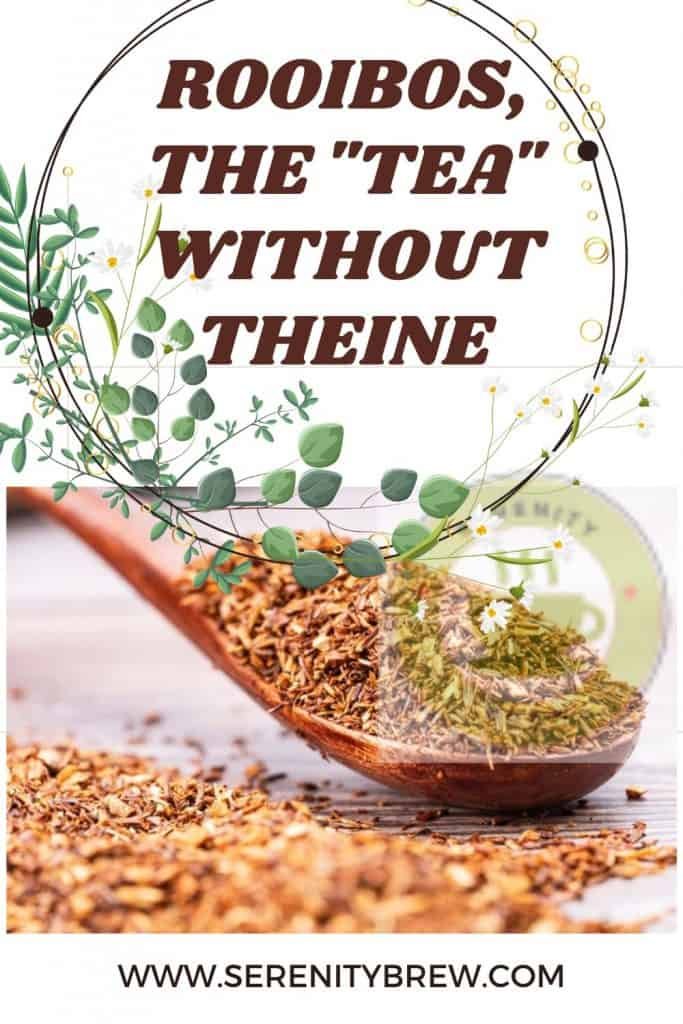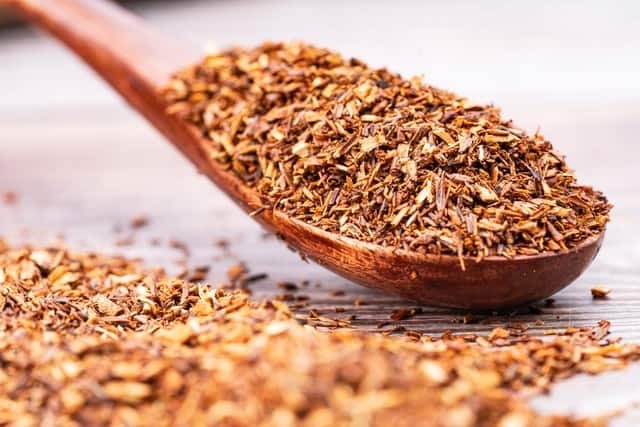
Rooibos is obtained from the leaves of Aspalathus linearis, a shrub that manages to thrive in the harsh conditions of the mountainous regions of South Africa.
Rooibos is famous for its nice malty flavor and naturally sweet (with nothing added). The local population habitually consumed it long before the European settlers appeared, who adopted the customs of the natives in substitution of their longed-for tea.
Rooibos is rich in antioxidants and polyphenols and, in fact, the only known source of aspalathin, a peculiar polyphenol that is being studied for its health properties.
Does rooibos have theine/caffeine?
Rooibos, literally Red Bush, is obtained from the leaves of Aspalathus linearis, unlike teas, which are obtained from Camellia sinensis. Rooibos, then, should not be confused with teas. It is a tisane and does not contain theine.
Theine is a chemical compound with stimulating effects that is found in nature, in different plants such as tea, coffee or guarana. Depending on the plant where it comes from, it can be called theine, caffeine or guaranine.
Consuming limited doses of caffeine is generally healthy, but going overboard can have negative effects such as heart palpitations, anxiety, migraines, and sleep-related problems.
For these reasons, many people decide to look for alternatives to coffees and teas and limit their caffeine intake. Rooibos is an excellent decision, since its caffeine content is zero and its flavor is fabulous.
Another reason to substitute your cup of tea for a rooibos is the tannins. These do not represent a problem in most cases, but they are known to interfere with the absorption of certain nutrients such as iron. If you suffer from anemia, rooibos is a good choice, as its tannin levels are significantly lower than tea.
It is also recommended to drink rooibos instead of tea if you have kidney problems. Rooibos does not contain oxalic acid, a component that, consumed in large quantities, is related to the formation of kidney stones.
Additionally, rooibos has many health benefits due to its high content of antioxidants and polyphenols. Let’s see them.
Benefits of rooibos for health and beauty
The health benefits of rooibos came to the attention of the scientific community in the 1960s. Rooibos stands out for its high antioxidant content, it is also the only known source of aspalathin, a powerful antioxidant that could play an important role in the fight against various diseases.
To this day, a large number of scientific studies on the benefits of rooibos. The evidence obtained so far is mainly based on in vitro and animal studies that point to potential beneficial effects for humans. Here you can locate specific scientific studies on rooibos.
In a study on rats, rooibos demonstrated properties to protect the rat brain against damage caused by oxidative stress. This could mean applications of compounds derived from this plant for the treatment of Alzheimer’s.
Free radicals are known for their ability to damage the DNA of cells and cause cancer. They also react with cholesterol, causing blood vessel clogging and ultimately cardiovascular disease. Rooibos is rich in polyphenols, compounds produced by plants. The complex blend of polyphenols in rooibos can help neutralize these free radicals and limit associated diseases.
Rooibos also has applications in the field of beauty. The warm infusion can be used to soothe tired, red eyes or as a refreshing skin toner. The infusion also brightens dark hair if used to lighten after washing.
Traditional South African medicine refers to the properties of rooibos to eliminate colic in babies, heal wounds and treat the skin. A popular South African acne remedy mixes rooibos with cider vinegar and a little oatmeal to make a paste that is applied to the skin.
Types and flavors
Rooibos is consumed in two different ways. The most common commercially, and known simply as rooibos, is the one that goes through an oxidation process. This process produces the distinctive reddish-brown color and characteristic flavor.
Rooibos is famous for its sweetish flavor reminiscent of hibiscus tea. Depending on the duration of the oxidation process, your infusion can have floral, woody or even smoky aromas.
Another variety is called green rooibos. This does not go through the oxidation process, it is simply dried in the sun in a similar way to green tea. Its production process is more demanding and, therefore, it is usually more expensive than traditional rooibos. It has a higher composition in antioxidants and its infusion is yellowish instead of reddish.
Green rooibos has herbaceous and malty flavors and a powerful infusion of body.
Vanilla rooibos
The combination of something sweet with vanilla is always a winner. Vanilla-flavoured rooibos preparations are common and are among the best-selling in supermarkets.
The naturally sweet flavor of rooibos combines excellently with the aromatic vanilla.
Orange rooibos
For lovers of citrus aromas, the combination of rooibos and orange is perfect. Following this line, it is also possible to find rooibos flavored with lemon or even with bergamot, which would be a version made from rooibos and, therefore, without caffeine of the famous English Earl Gray tea.
Rooibos cinnamon
Cinnamon is one of those spices that we usually associate with sweetness. Rooibos with cinnamon is a very comforting and aromatic infusion, ideal for cold days. A very good mix and that will not take away your sleep.
Rooibos chai
The ability of rooibos to absorb aromas makes it susceptible to brave combinations. Taking chai tea as an example, rooibos chai adds spices such as ginger, cardamom, cloves, anise and many others to create a tremendously aromatic infusion, very tasty and without any exciting element.
Plant
The scientific name for the rooibos bush, which literally means red bush in Afrikaans, is Aspalathus linearis.
It is a plant of the legume family that grows in the mountainous area of the South African fynbos. This region has a climate characterized by great contrasts, with hot, arid summers and winters with abundant rainfall.
The plants reach two meters and bloom each spring with a yellow flower that produces a small legume that contains the seed.
The bushes take 18 months to grow large enough to be harvested. The harvesting season is summer. During harvest, their stems are cut by hand and lightly crushed by mechanical means to facilitate the oxidation process. Longer oxidation processes achieve sweeter flavors and redder infusions.
Origin and history
Rooibos is grown in the Cederberg region of South Africa, a mountainous area in the Western Cape province with hot, dry summers and cold, wet winters.
Dutch settlers began drinking rooibos in imitation of locals around 1770. They were looking for a replacement for black tea, a prohibitively expensive luxury that had to be imported from Europe.
The people of the area used to let the rooibos dry in the sun after slightly crushing it. In 1900, Benjamin Ginsberg, an immigrant and entrepreneur, coming from a family related to the elaboration of teas, applied traditional techniques related to the world of teas to the elaboration of rooibos.
Until 1930, the cultivation of rooibos had been practically impossible, since the collected seeds could not germinate properly. The botanist Pieter Le Fras Nortier managed to solve this problem and is considered a fundamental figure in the history of rooibos production.
The consumption of rooibos became popular during World War II due to the shortage of tea and has continued to this day.
Gradation and qualities of rooibos
South Africa produces 14,000 tons of rooibos annually, most of it for export.
The popularity and consumption of rooibos in the world has not stopped growing in recent years.
The quality of rooibos is measured by the relationship between leaves and stems that are part of the base of the infusion, similar to tea. A greater quantity of leaves achieves a darker infusion, with a more intense flavor.
The highest quality rooibos are usually destined for export.
Beyond tisane, recipes with rooibos
Rooibos is a versatile ingredient. Its sweet flavor base adapts to many situations and its popularity has taken it far beyond the world of infusions.
Rooibos can be combined with other herbs to create herbal teas. You can easily find combinations such as rooibos with vanilla, with basil, with cinnamon and orange, with strawberries and with a long etcetera of flavors.
It is also common to consume rooibos cold and with ice, combined with fruit flavors such as pineapple, apple or lemon. Ideal for the summer.
Rooibos is also consumed in innovative formats. In sophisticated establishments you can choose to replace the coffee in your cappuccino or latte with rooibos. A version of rooibos espresso has recently been marketed.
The use of rooibos in the kitchen is even more original. South African gastronomy has promoted its use as its own local ingredient. Recipes as interesting as stews with rooibos, legumes with rooibos, marinade sauces, desserts or even cocktails with rooibos have been generated.
How to prepare the best rooibos

Rooibos is an excellent choice in both summer and winter. Its flavor is delicious both in comforting infusions and in refreshing iced drinks.
It can be said that rooibos is not a delicate infusion. Once done, you can keep the infusion for weeks in the fridge without affecting its flavor. You can also reheat it without a problem, unlike some teas, it won’t develop bitter flavors.
quantities
If you’re using bulk rooibos, you’ll want to use amounts closer to two teaspoons per cup of water.
Water temperature
Use boiling water. Don’t worry, 100ºC.
Time
Let the rooibos rest for about 5 minutes.
And that’s it! Rooibos goes well with a splash of milk and you can sweeten it up a bit more with honey or sugar.
Add rooibos to your list of infusions to discover new flavors and have a plan B for those days when you have taken too much theine.
